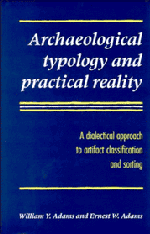 Archaeological Typology and Practical Reality
Archaeological Typology and Practical Reality Book contents
- Frontmatter
- Contents
- List of figures
- List of tables
- The archaeologist's preface
- The philosopher's preface
- PART I Introductory
- PART II The nature of types and typologies
- 3 Dimensions and elements of “typehood”
- 4 Perceptual and conceptual foundations
- 5 The dialectics of type formulation
- 6 The nature of types
- 7 The structure of typologies
- 8 A synthetic definition of typology and type
- PART III Typology in action: the Medieval Nubian Pottery Typology
- PART IV Pragmatics of archaeological typology
- PART V Classification, explanation, and theory
- Appendices
- References
- Index
3 - Dimensions and elements of “typehood”
Published online by Cambridge University Press: 23 November 2009
- Frontmatter
- Contents
- List of figures
- List of tables
- The archaeologist's preface
- The philosopher's preface
- PART I Introductory
- PART II The nature of types and typologies
- 3 Dimensions and elements of “typehood”
- 4 Perceptual and conceptual foundations
- 5 The dialectics of type formulation
- 6 The nature of types
- 7 The structure of typologies
- 8 A synthetic definition of typology and type
- PART III Typology in action: the Medieval Nubian Pottery Typology
- PART IV Pragmatics of archaeological typology
- PART V Classification, explanation, and theory
- Appendices
- References
- Index
Summary
Since our book is about typologies and types, we should in theory begin by explaining what we mean by the two terms. However, this is much more easily said than done. We will suggest in later pages (especially Chapter 6) that types are among the most complex of all human ideas; so much so that they often defy formal definition (cf. Klejn 1982: 35–6). In addition, a typology has peculiarities and complexities of its own (see Chapter 7). Although by definition it is a system of types, it is more than just the sum of its parts.
We will leave aside until Chapter 7 the question of what is a typology, and will concentrate here on the question of what is a type. Some scientists would probably argue that it is a group of similar things, others that it is an idea or group of ideas about the similarity of things, still others that it is a form of words describing things and their similarity (cf. Dunnell 1986: 191–3). If our discussion is to encompass all of the different meanings given to the word “type” in the scientific literature, however, we must begin by recognizing that all three of the usages described above are legitimate. That is, a type in the fullest sense consists of things, plus our ideas about them, plus the words and/or pictures in which we express those ideas (see especially Leach 1976: 17–22).
- Type
- Chapter
- Information
- Archaeological Typology and Practical RealityA Dialectical Approach to Artifact Classification and Sorting, pp. 29 - 38Publisher: Cambridge University PressPrint publication year: 1991


